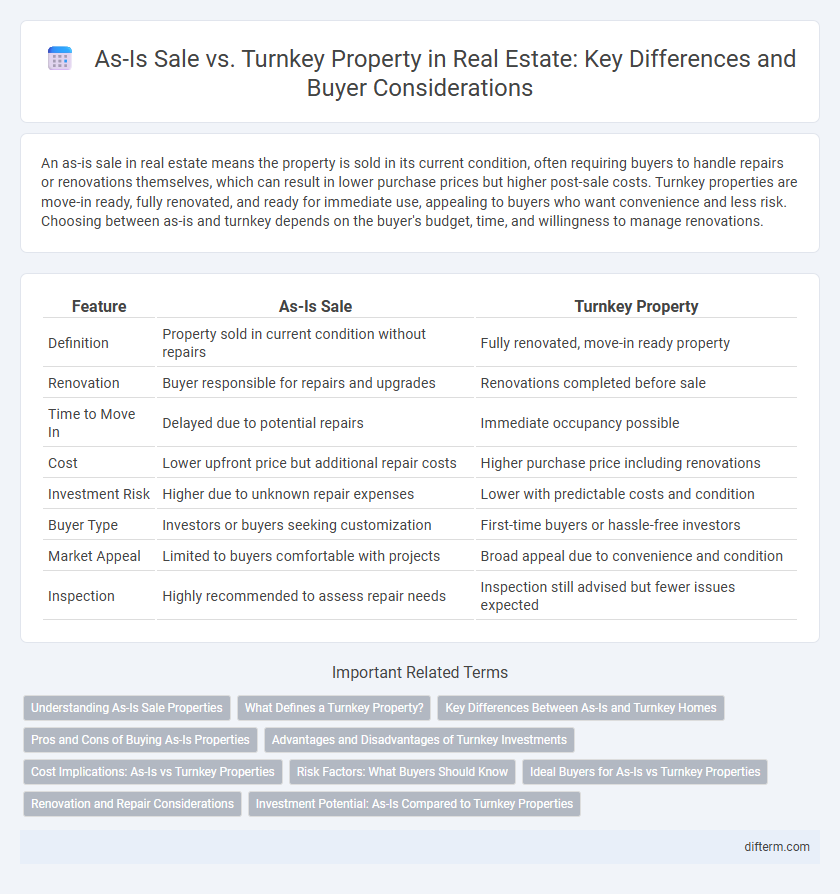An as-is sale in real estate means the property is sold in its current condition, often requiring buyers to handle repairs or renovations themselves, which can result in lower purchase prices but higher post-sale costs. Turnkey properties are move-in ready, fully renovated, and ready for immediate use, appealing to buyers who want convenience and less risk. Choosing between as-is and turnkey depends on the buyer's budget, time, and willingness to manage renovations.
Table of Comparison
| Feature | As-Is Sale | Turnkey Property |
|---|---|---|
| Definition | Property sold in current condition without repairs | Fully renovated, move-in ready property |
| Renovation | Buyer responsible for repairs and upgrades | Renovations completed before sale |
| Time to Move In | Delayed due to potential repairs | Immediate occupancy possible |
| Cost | Lower upfront price but additional repair costs | Higher purchase price including renovations |
| Investment Risk | Higher due to unknown repair expenses | Lower with predictable costs and condition |
| Buyer Type | Investors or buyers seeking customization | First-time buyers or hassle-free investors |
| Market Appeal | Limited to buyers comfortable with projects | Broad appeal due to convenience and condition |
| Inspection | Highly recommended to assess repair needs | Inspection still advised but fewer issues expected |
Understanding As-Is Sale Properties
As-is sale properties are sold in their current condition without any repairs or renovations from the seller, transferring all risks and responsibilities to the buyer. Buyers of as-is properties must conduct thorough inspections and budget for potential repairs to accurately assess the investment's cost. This approach often results in a lower purchase price, attracting investors looking for renovation opportunities or discounted market entries.
What Defines a Turnkey Property?
A turnkey property is defined as a fully renovated and move-in ready real estate asset requiring no immediate repairs or upgrades, allowing buyers to occupy or rent it out immediately. These properties often come with modern amenities, updated systems, and compliance with current building codes, ensuring hassle-free ownership. Unlike as-is sales, turnkey homes streamline the purchase process by eliminating uncertainties related to condition and additional investment costs.
Key Differences Between As-Is and Turnkey Homes
As-is homes are sold in their current condition without any repairs or upgrades, often appealing to investors or buyers seeking lower prices with renovation potential. Turnkey properties come fully renovated and move-in ready, providing convenience and immediate usability for buyers. The key differences lie in the level of investment needed after purchase, with as-is homes requiring time and resources for repairs, whereas turnkey homes eliminate those concerns through prior refurbishment.
Pros and Cons of Buying As-Is Properties
Buying as-is properties often means lower purchase prices and less competition due to the property's current condition, appealing to investors looking for potential value-add opportunities. However, as-is sales transfer all repair responsibilities and risks to the buyer, who may face unexpected renovation costs and complications that affect time and budget. This option requires thorough inspections and a risk tolerance for dealing with possibly significant structural or system issues.
Advantages and Disadvantages of Turnkey Investments
Turnkey property investments offer the advantage of immediate rental income and reduced renovation risks, appealing to investors seeking hassle-free ownership. However, these properties often come with higher purchase prices and limited customization options compared to as-is sales. Investors should weigh the predictability of returns against potential cost premiums and less control over property condition before committing.
Cost Implications: As-Is vs Turnkey Properties
As-is properties typically require significant repairs and renovations, leading to unpredictable costs that can escalate quickly. Turnkey properties, while generally more expensive upfront, offer a hassle-free investment with fewer unexpected expenses due to their move-in ready condition. Evaluating the cost implications of each option helps investors balance initial outlay against long-term financial risk and potential return on investment.
Risk Factors: What Buyers Should Know
As-is property sales typically involve higher risk due to potential hidden defects and the buyer assuming responsibility for repairs, often without seller guarantees or inspections. Turnkey properties reduce risk by being move-in ready with completed renovations, inspections, and warranties, providing buyers with greater certainty and fewer unexpected costs. Understanding these risk factors helps buyers make informed decisions based on their budgets, timelines, and risk tolerance in the real estate market.
Ideal Buyers for As-Is vs Turnkey Properties
Ideal buyers for as-is properties are investors or experienced homebuyers comfortable with renovation projects and potential repairs, seeking lower purchase prices and value-add opportunities. Turnkey properties attract buyers prioritizing convenience and immediate occupancy, such as first-time homeowners or those relocating, who prefer move-in ready homes with minimal maintenance. Understanding these buyer profiles helps tailor marketing strategies to align with buyer needs and property conditions in the real estate market.
Renovation and Repair Considerations
As-is sales require buyers to accept properties in their current condition, often necessitating significant renovations and repairs, which can impact overall investment costs and timelines. Turnkey properties, on the other hand, have completed renovations and are move-in ready, minimizing the need for immediate repairs and allowing for quicker occupancy or rental potential. Assessing the extent of necessary repairs or upgrades in as-is properties is crucial for accurate budgeting and avoiding unexpected expenses.
Investment Potential: As-Is Compared to Turnkey Properties
As-is properties often offer higher investment potential due to lower purchase prices and opportunities for value appreciation through renovations and improvements. Turnkey properties provide steady, immediate rental income with minimal management effort but typically come at a premium price, reflecting lower risk. Investors seeking significant long-term gains may favor as-is sales for their flexibility and potential for equity growth.
as-is sale vs turnkey property Infographic

 difterm.com
difterm.com